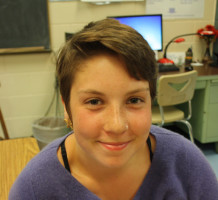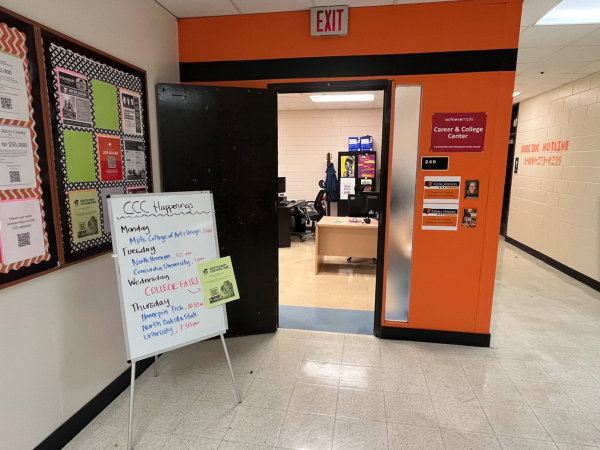Homeless teens don’t always fit stereotypes
January 10, 2014
“The only person I remember was named Crazy K,” recalls Sally, not her real name, a sixteen year old junior at South. Lively yet hardened, she talks with her hands and with honesty. She had a grin on her face throughout her whole story. “She drove 80 miles an hour on black ice, through Texarkana, into Texas. It was terrifying.”
Sally is one of 6,822 youth in Minneapolis Public Schools who identify as homeless or “highly mobile.” At age 15, Sally ran away from her home and a “toxic relationship” she shares with her mother. Sally, her boyfriend, and two other friends ran away from their homes in Minneapolis and hitchhiked down to Carthage, Texas.
“I took all the school stuff out of my backpack, grabbed two pairs of pants and a sweater, then a notebook and a pen. I wanted to write down everything,” Sally smiles further and spreads her hands out to encapsulate all her “crazy stories”. When Sally did return home, after getting arrested in Carthage and flown back to Minneapolis, she stayed for a few months with her mother and then ran away again. Sally’s trip to Texas was the first of three attempts to escape her tumultuous home life.
Students become homeless for a wide range of reasons. “Don’t listen to the stereotypes,” warned Alissa Elles, South’s teen homeless outreach resource. “Homelessness doesn’t look a certain way, doesn’t act a certain way, doesn’t come from a certain culture.”
Counting on her fingers Sally lists: “There are people who have been kicked out, or ran away, or ran because they’re in an abusive situation, or when they turned 18 their parents kicked them out,” These are some of the ways people she met became homeless, “ and they have no idea where to go or what to do because they know nothing besides selling weed, or whatever.”
Sally waves to someone in the hall and smiles. “You have to be social or you’re going to lose your head, because you have no one to talk to, and you are in such a depressing situation that you need friends–even if they are not your real friends, just people to talk to about what you are going through.”
The second time Sally ran away, she went to school and didn’t come back home. It was winter at the time. All she had with her were the clothes on her back. “I was out of school and I was just walking around doing nothing. I was trying to figure out what to do, ‘Now you’re gone, now you’re free, now what?’ Most of the time I slept outside. It was winter, so most of the time I was sleeping outside; it was cold and blizzarding; I was barely eating.”
Her second flight from home was spontaneous because she didn’t want to deal with the argument she would have to deal with if she returned to get her things. “My mom had me at age 16, she made a poor decision, and now I’m a poor decision. I guess I’ve always thought about it like that.”
A classroom cheerily sings happy birthday in the background while she explains her relationship with her mom to me; it feels strangely eerie and haunting. “We’ve always had a toxic relationship, but we tried to make it seem like we can talk to each other. The facade we put on was even worse because, when we were alone, there is silence, tension, and anger.”
Sally’s mom did not file a missing persons report the second time Sally ran away from home. Sally and her boyfriend were questioned by the cops; his name showed up but not hers. After this, she got herself into a shelter.
“I was fifteen at the time, but the shelter was 16-21, so I lied to them about my name, my age, my everything,” Sally says, exaggerating this with her hands, “I just wanted somewhere warm to be. I was really good at concealing. I was quiet.”
The shelter found out her age a month after her arrival and transferred her to Bridge for Youth, a temporary place for runaway and homeless young adults. “I went back to my mom’s house. It just gets worse every time. Two months later, I had left again. But it was summer time so it was easier, and I had friends that I had made on the streets that had homes but chose to bum on the streets.”
She illustrates that living on the street is hard because of the cold, because of the hunger, but also because people saw her as vulnerable. “I ran away the third time, and because it was just me and me being a female, men thought me to be weak–because I am in such a vulnerable situation, that I would do anything to make money. But I wasn’t. I wasn’t in a vulnerable situation. The only thing I would do to make money was to ask people for money. I had been offered more than fifteen times if I wanted to sell my body for money, sell weed for money; they had the you have to hustle to be on these streets mantra.”
Sally tells me that, although she never did sell her body or drugs, she did think about it and she thinks her life would have been easier if she would have done it. With the same cheery smile, Sally explains her experiences with drugs and violence as “continuous.” After a while the Bridges Program got her into the Transitions Program. During this time, she said, she was “coming off of really hard drugs, really terrible hard drugs. Being there I didn’t want to mess it up, so I just stopped. I cut it cold turkey. I was cold and shaking. I got these terrible migraines. I could barely see…that’s how bad the migraines were.”
Sally first got on drugs after talking to a guy at the Mall of America train station who gave her four cigarettes. “We were talking and I mentioned I was hungry and he said ‘come to my house, you can eat food.’ Normally, I wouldn’t have went to anyone’s house, but the conversation persuaded me that it was a safe place and that I would have someplace warm, and I could build up a life there.” Sally spent a few months there and realized the guy was a meth dealer, but he let her sleep at his house and eat there so she was in and out.
“At the time I was there, I had a boyfriend. He broke up with me for no reason. The thing is, I had nothing. Absolutely nothing. Nothing I could hold on to. He was my only physical thing. I didn’t care about myself; the only thing I cared about was him.”
Sally is still smiling, but for the first time in this interview she shifts eye contact and her voice wavers from its cheery demeanor. “He left me, and everything spiraled out of control. I went over to the guy’s house, and he always fixed up two lines, and usually I just go to sleep. But I sat down at the table, and that’s how it started. I just sat down. It was eight months of hell; now, I’m two months sober.”
Sally currently is living in in an apartment provided by the Transitions program and is figuring out her own way to get out of homelessness. She has signed up for food stamps, has a job, is working on applying for a second one. “I plan to be out the door and have my own place before I’m 18.”
Many students do get out of homelessness in high school, and Alissa Elles helps them get there.“I think the biggest issue is navigating those really large systems by themselves, because they don’t have the proper support on their own,” explained Elles. “Our job is to come in and be that buffer to help them navigate those really difficult systems, such as the county benefits, social security office, accessing vital document, even simple things as going grocery shopping and budgeting. I think their barriers of balancing adult responsibility and still being a teenager is hard.”
Sally advises:“If you’re in a situation where your home life sucks, don’t run away. That’s not the answer. The answer is finding somewhere else to be. And being on the streets: it’s not easy, it’s not cool…It’s f***ked up. You lose a lot of friends, and no one wants to help you when you’re down. What you have to do is deal with it on your own; you will have to deal with the fact that you are going to have to be independent.”












